Intel Haswell Low Power CPU Review: Core i3-4130T, i5-4570S and i7-4790S Tested
by Ian Cutress on December 11, 2014 10:00 AM ESTGaming Benchmarks on Processor Graphics
The faster processor graphics become, the more of the low end graphics market is consumed - if the integrated graphics are better than a $50 discrete GPU, there ends up being no reason to buy a discrete GPU. This might seem a little odd for some vendors who also have a discrete GPU business. The counter argument is that integrated graphics is only comparable to low-end GPUs, which are historically low margin parts and thus might encourage users to invest in larger GPUs, especially as demands in resolution and graphical eye-candy increase. The compute side is also important, and the homologation of discrete to integrated graphics architectures helps software optimized for one also end up accelerated on the other.
All our integrated processor graphics tests are performed at 1280x1024 at low settings.
F1 2013
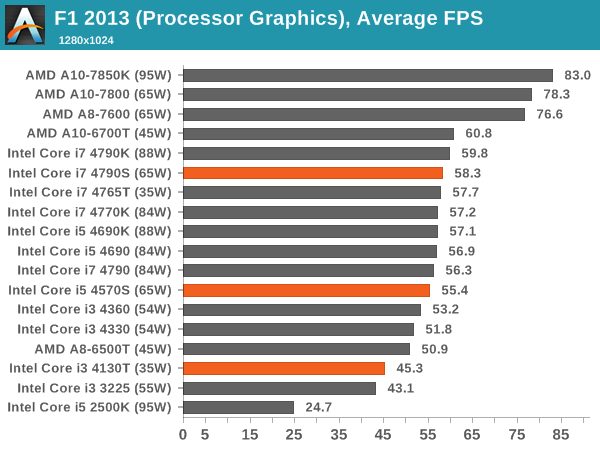

Bioshock Infinite
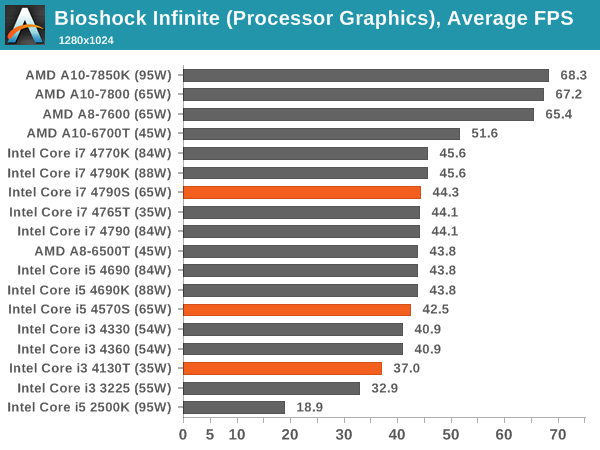
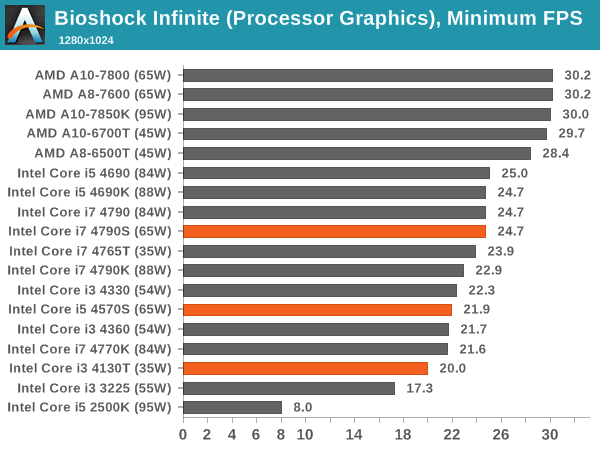
Tomb Raider
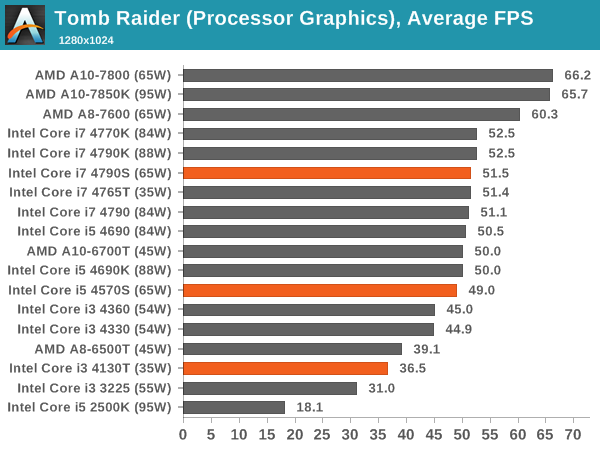
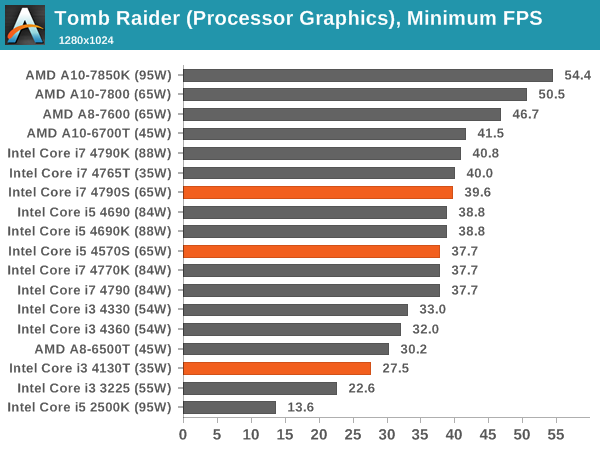
Sleeping Dogs
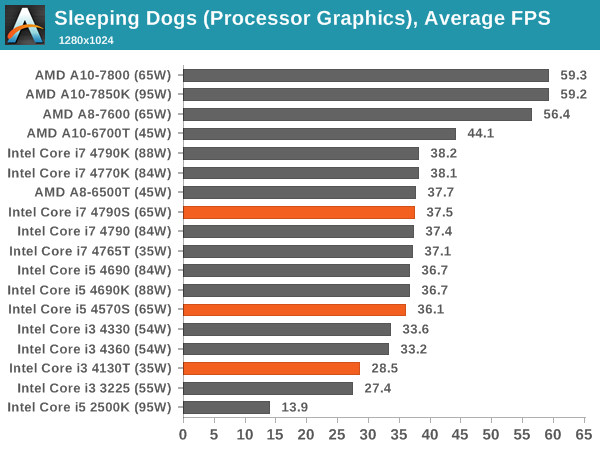
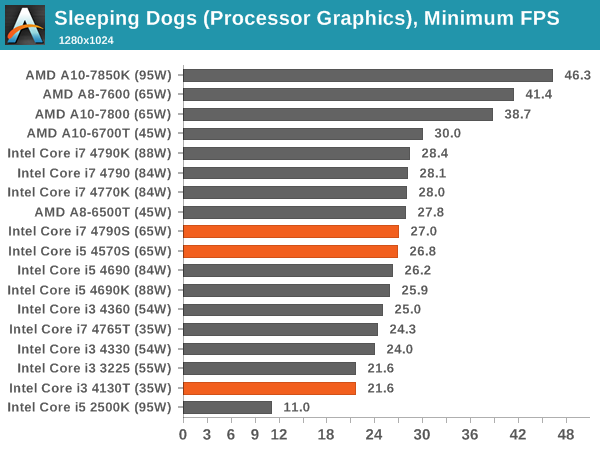
3DMark FireStrike















76 Comments
View All Comments
azazel1024 - Thursday, December 11, 2014 - link
Can we also move away from having a GPU in the system for tested idle and load power consumption? It is one more source of bluring on what is actually using the power. Everything on the chart has an iGPU and in most cases businesses or low power users are going to be leaning on the iGPU, not a dGPU. So seeing what system power consumption is without a dGPU is important, even if all systems have the same contribution from an identical dGPU (it means a lot more if the dGPU is contributing 10w at idle...so suddenly you have a 3w difference between processor models...but the idle is 10w for one and 13w for another, instead of 20w and 23w).barleyguy - Thursday, December 11, 2014 - link
Delta charts are more accurate, and easier to generate, than absolute numbers. An absolute number will either be "total system power" or "total system power minus an estimate of non-processor power". The first is useless as information about the processor, because it isn't comparable across platforms, and the second is only an estimate unless hardware mods are done for power taps. For a chart that has such a large number of processors on it, the estimation errors for calculating discrete draw would likely put the chips in the wrong order.rootheday3 - Thursday, December 11, 2014 - link
For people who are using the onboard graphics, a 1250 power supply, even one that is Gold rated, is going to be pretty inefficient at low power.I know it is nice/convenient to have a single common setup for testing both with and without graphics and it makes things "apples-to-apples" but it doesn't match how I would build a system. If I really only intend to use the onboard graphics, I would try to pick a power supply that was sized appropriately.
For users trying to understand the platform/cpu idle and load power, it seems like it would be beneficial to have both idle and load power reported AND appropriately sized power supply for the test conditions.
Daniel Egger - Thursday, December 11, 2014 - link
> If I really only intend to use the onboard graphics, I would try to pick a power supply that was sized appropriately.Good luck with that. There're almost no appropriately sized PSUs for such systems available on the market; seems like they're all exclusively designed for and sold to big OEMs.
azazel1024 - Thursday, December 11, 2014 - link
Not really. The idle power of the CPU very well might be different between the different CPUs combined (which can be sussed out if they all use the same hardware configuration excepting the CPU). Idle to load might only be a 10w difference for one CPU...but it might idle using 20w for the CPU. Another CPU might be a 15w difference from idle to load, but it might idle at 5w...making it a much more power efficient CPU overall.rootheday3 - Thursday, December 11, 2014 - link
At idle, CPUs enter pkg c states and burn less than 1w regardless of sku/stepping/binningpiasabird - Thursday, December 11, 2014 - link
http://download.intel.com/support/processors/corei...It must be because intel is not selling the CPU's in boxed retail set. 4360T, 4350T, 4330T, 4160T, 4150T, 3250T are not available boxed, but are valid parts. My guess is you have to order them as tray and are only available to OEM's. However, they may be available through a small OEM custom computer builder shop.
sweetie peach - Thursday, December 11, 2014 - link
I have been using the i7-4790S for the past 4 months and there is something very strange about the results. The cinebench multithreaded bench is way too high. This cpu turbos to 3.6GHz with 4 cores so it can not possibly have the same score as a non-S that turbos to 3.8 GHz with 4 cores. Also my own average results are 160 for single and 740 for multi (HT enabled of course). Maybe there is something wrong with my setup but it doesn't feel slow in any way. It was very difficult to get hold of but it made sense because i want a very quiet computer even at load.otherwise - Thursday, December 11, 2014 - link
Do any of these support ECC? Or do you still need a sandy-bridge era i3 to get that feature?Cerb - Sunday, December 14, 2014 - link
Most, if not all, the Haswell Core i3 CPUs support ECC, as do all of the Xeon E3 V3 series.